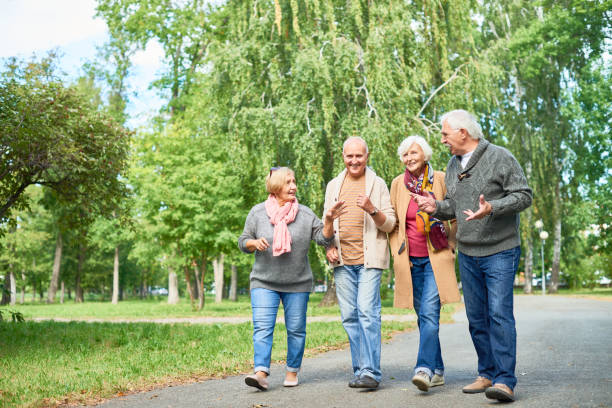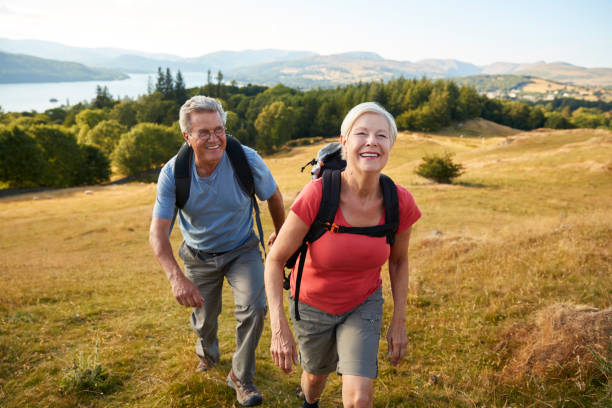
20 Health Benefits of Walking
Walking is good for mind, body, and soul. Here are the top 20, evidence-based, best reasons we have found to hit the pavement, the trail, the sand, and even the treadmill:
Walking for Physical Exercise

Most Americans do not get enough exercise, and 25% of us are completely sedentary![1] The good news is that this is super-easy to change.
Walking is a low-impact, aerobic exercise that helps improve cardiovascular health, muscle strength, and endurance. The great thing about walking is that it can be as easy or as challenging as you like.
Saunter through the easy streets of the French Quarter in New Orleans, wander the rolling hills of the Appalachians, or aim for the windy summit of Goatfell on Scotland’s Isle of Arran. It doesn’t matter where you walk, just get out there and get moving.
Walking for Weight Loss

Regular walking can aid in weight loss and weight maintenance by burning more calories than you might think. According to the CDC, sticking to a walking routine of just 30 minutes per day, five days a week, at a moderate pace of 3.5mph, can result in a pound of weight loss every month, even without any other lifestyle changes at all.[2]
If weight loss is your goal, imagine the possibilities if you couple your new walking regimen with dietary changes!
Walking for Mental Health

We all have our life stressors. Work, kids, relationships, the holidays, and more all take a toll. According to the Mayo Clinic, stress has negative effects on your body, your mood, and your behavior. Stressed-out people can have a variety of responses. Among other negative reactions, they may experience chest pain, overeat, lose sex drive, or even find themselves abusing drugs or alcohol to cope. Walking can reduce stress, anxiety, and depression while promoting a positive mood and mental well-being.[3]
The pace of your walk doesn’t even need to be fast to result in release of mood-boosting metabolites. A slow, comfortable stroll will also induce relaxation. This is particularly true if you are able to stay mindful and present in the moment as you walk, rather than ruminating on all the outside factors causing your stress.[4]
Walking for Bone Health

For those of us, especially women, in our fabulous fifties and beyond, bone health can present a real issue. As we age, most of us, for good reason, are faced with recommendations from our physicians for all variety of medications. Many women our age need to start medications to improve and ensure bone strength. Unfortunately, these medications come with side effects and risks that can be significant.
Weight-bearing activities like walking can help strengthen bones and reduce the risk of osteoporosis. This can mean avoiding or postponing exposure to medications that, while helpful for bone health, can complicate our lives in other ways.[5]
For many of us, this stage of life is a time of exciting change and newfound freedom. The kids are grown and moving out, and we’re ready for frolicking and fun, not fractures.
Walking for Flexibility

Creaky joints and tight muscles are par for the course as we age. Walking promotes joint mobility and flexibility, which is especially beneficial for older adults.
Harvard Medical School no longer recommends stretching before a workout. Instead, they advocate stretching after a warm-up, such as an easy walk. This combination of walking and stretching improves range of motion and balance and decreases pain and risk of injury.[6]
Walking for Sleep Improvement

The verdict is in! Regular walking can lead to better sleep patterns and improved quality of sleep. Sleep disturbances are common for middle-aged and older adults. In a study by the National Institutes of Health, taking just 2000 steps more per day resulted in better sleep. Interestingly, they found this was particularly true for women.[7]
Walking for Digestive Health

Walking after meals can aid in digestion and reduce bloating. A recent meta-analysis also found that light-intensity walking after eating resulted in lower blood glucose levels than sitting.
Even just a few minutes of walking after a meal makes a huge difference. A short walk can prevent spikes in blood sugar. It is thought that such sharp spikes and crashes in blood sugar can contribute to the development of Type 2 diabetes.[8] Your body will thank you for getting off the couch after that brunch!
Walking for an Energy Boost

Walking increases blood circulation and oxygen flow, providing an energy boost. If we learned anything in school, it’s that the mitochondria is the powerhouse of the cell. Exerting yourself by walking turns those little suckers on and increases the body’s energy supply.
Toni Golen, MD, editor of Harvard Women’s Health Watch, also says that walking also results in an exercise-induced increase in hormone levels that makes you feel energized.[9]
Walking for Immune System Support

Regular physical activity like walking can strengthen the immune system, reducing the risk of illnesses. In fact, even a single exercise session can provide an immune system boost!
20-30 minutes of brisk walking (2.5-4.0 mph) activates several types of immune cells, and regular walking is thought to contribute to a stronger immune system.[10]
Walking for Improved Cognitive Function

Physical activity has been repeatedly shown to reduce risk for neurodegenerative diseases. Walking is associated with improved cognitive function, memory, and focus.
In a study testing cognitive function and physical fitness in older adults, walking for one hour three times a week over a six-month period improved attention, visuospatial function, memory, frontal/executive function, cardiorespiratory fitness, lower extremity muscle strength, and balance.[11] Get out there and ease the strain on your brain!
Walking for Social Interaction

Loneliness and social isolation are serious and complex health problems. Walking with friends, family, or in walking groups provides an opportunity for socializing and connection. It can foster social support systems and decrease subjective feelings of loneliness.[12]
Walking doesn’t have to be a time-consuming or even a pre-planned activity. It can be a spur-of-the-moment turn around your own neighborhood that fosters interactions with others you may meet on the way, opening the door to future engagement with those around you.
Walking to Connect with Nature

Walking outdoors allows you to enjoy nature, which has its own positive effects on well-being. Outdoor activities, like walking, raise our levels of Vitamin D, reduce our blood pressure, and lower our cancer risk.
It’s been shown that patients with a view of deciduous trees from their hospital room heal faster than those with a view of a brick wall. The patients with a nature view also liked their nurses more and didn’t need as much pain medication. Adults can reduce their blood pressure with a simple 30-minute walk in a park.
And, in a study of the link between nature and cancer, people who took two long walks in nature had both an increase in cancer-fighting cells and in the activity of those cells, and the cells remained at this elevated activity level for the next month.[13]
Walking for a Creativity Boost

A leisurely walk can stimulate creative thinking and problem-solving. A Stanford study showed that creative output increases by an average of 60% when a person is walking instead of sitting.[14]
If you value divergent, out-of-the-box thinking, or if you have a problem to solve, then walking can get you there!
Walking for Heart Health

Regular walking can lower blood pressure and reduce the risk of heart disease. According to the Harvard School of Public Health, moderate-intensity workouts, such as walking, confer the same benefits as higher-intensity activity, like running, in terms of reducing high blood pressure, high cholesterol, and diabetes.
And walking is less likely to strain joints or cause injury. A diet low in salt and saturated fat combined with 2000 extra steps per day can lower blood pressure by 15 points![15]
Walking for Joint Pain Relief

Walking can help reduce joint stiffness and pain, particularly for individuals with arthritis. Matthew Golan, editor of Harvard Men’s Health Watch, explains that knee pain in people with osteoarthritis can be reduced by walking. In the study he cites, participants who walked for exercise were less likely to develop knee pain over the next eight years than those who did not walk for exercise.
Additionally, among those study participants who already had knee pain at the beginning of the study, regular walkers had less knee damage than non-walkers.[16]
Walking to Boost Metabolism

Walking regularly can increase metabolism and aid in weight management. The Mayo Clinic tells us a brisk 30-minute walk on the regular will burn about 150 calories per day![17]
By making walking a habit, you can promote an increase in lean muscle mass to raise your resting metabolic rate and promote weight loss.
Walking is Accessible and Affordable

Walking requires no special equipment and can be done almost anywhere, making it a convenient and cost-effective exercise. You can walk in the city, the country, and everywhere in between.
The accessibility and affordability of walking make it easier to sustain than other forms of exercise. The chances are you already have everything you need to get started, so grab those comfy shoes and get going.
Walking to Improve Balance and Coordination

Walking helps improve balance and coordination, reducing the risk of falls, especially in older adults. As we age our balance typically worsens. Poor balance can lead to falls and fractures, such as hip fractures, which can have serious health consequences.
Walking helps build lower body strength, which is an important element of balance.[18] Keep walking, and keep your independence!
Walking for Longevity

Studies have shown that regular walking is associated with increased life expectancy, and increasing your walking duration and pace gives even more benefit.[19]
It’s important to remember, though, that any movement is better than none at all if it’s a longer life you’re looking for. You don’t need the skills and stamina of a D1 athlete to see longevity benefits, you just need to get out there and walk.
Walking for Positive Environmental Impact

Choosing to walk instead of driving can reduce carbon emissions and contribute to a cleaner environment. There’s no doubt about it. Walking is more sustainable than driving.
A walkable environment can reduce greenhouse gas emissions by 4 tons a year compared to an automobile-dependent suburb. Walkable environments are more compact and limit land use compared to suburban sprawl, and fewer cars means better air quality, more beautiful spaces, and less traffic noise.[20]
Remember, walking doesn’t have to be an intense exercise to be beneficial; even a short daily walk can make a significant difference in your overall health and well-being.

As always, make sure to consult your personal physician before engaging in an exercise plan. Harvard Medical School’s Harvard Health Publishing recommends the following:
“If you’re in doubt about your ability to take on even a modest exercise program, we recommend filling out the Get Active Questionnaire (GAQ), a tool developed by the Canadian Society for Exercise Physiology to help people determine whether they should talk to a doctor before embarking on, or ramping up, an exercise program. You can find it at www.health.harvard.edu/GAQ. Be sure to talk to your doctor about whether it’s safe to exercise if any of the following apply:
- You’ve had hip or knee surgery.
- You’ve been experiencing pain in your hip, knee, foot and ankle, or back.
- You have a chronic or unstable health condition, such as heart disease, or you have a respiratory ailment, high blood pressure, osteoporosis, diabetes, or several risk factors for heart disease.”
References:
[1] Centers for Disease Control and Prevention, Physical Activity and Health: A Report of the Surgeon General, November 17, 1999.
[2] Centers for Disease Control and Prevention, Physical Activity for a Healthy Weight, 2023, April 26, cdc.gov. Retrieved August 1, 2023, from https://www.cdc.gov/healthyweight/physical_activity/index.html
[3] The Mayo Clinic, Stress Management, 2021, March 24, mayoclinic.org. Retrieved August 1, 2023, from https://www.mayoclinic.org/healthy-lifestyle/stress-management/in-depth/stress-symptoms/art-20050987
[4] North Dakota State University, Walking Can Help Relieve Stress, Extension and Ag Research News, 2011, August 8, ag.ndsu.edu. Retrieved August 1, 2023, from https://www.ag.ndsu.edu/news/newsreleases/2011/aug-8-2011/walking-can-help-relieve-stress/
[5] Vescovi, P, Nammour, S, Bisphosphonate-Related Osteonecrosis of the Jaw (BRONJ) therapy. A critical review. Minerva Stomatol. 2010 Apr;59(4):181-203, 204-13.
[6] Harvard Medical School, Benefits of flexibility exercises, 2015, April 16. Harvard Health Publishing. health.harvard.edu. Retrieved August 1, 2023, from https://www.health.harvard.edu/staying-healthy/benefits-of-flexibility-exercises
[7] Sullivan Bisson, A, et al. Walk to a Better Night of Sleep: Testing the Relationship Between Physical Activity and Sleep, Sleep Health. 2019 Oct; 5(5): 487–494. Published online 2019 Jul 26. doi: 10.1016/j.sleh.2019.06.003
[8] Buffey, A.J., Herring, M.P., Langley, C.K. et al. The Acute Effects of Interrupting Prolonged Sitting Time in Adults with Standing and Light-Intensity Walking on Biomarkers of Cardiometabolic Health in Adults: A Systematic Review and Meta-analysis. Sports Med 52, 1765–1787 (2022). https://doi.org/10.1007/s40279-022-01649-4
[9] Golen, T., et al. Does exercise really boost energy levels? 2021, July 1, Harvard Health Publishing. health.harvard.edu. Retrieved August 1, 2023, from https://www.health.harvard.edu/exercise-and-fitness/does-exercise-really-boost-energy-levels
[10] Nieman, D, et al. Immune response to a 30-minute walk. Med Sci Sports Exerc. 2005 Jan;37(1):57-62. doi: 10.1249/01.mss.0000149808.38194.21.
[11] Kang, S, et al. The Beneficial Effects of Cognitive Walking Program on Improving Cognitive Function and Physical Fitness in Older Adults. Healthcare (Basel). 2021 Apr; 9(4): 419. Published online 2021 Apr 5. doi: 10.3390/healthcare9040419
[12] Glover, T, et al. Neighborhood Walking and Social Connectedness. Front Sports Act Living. 2022; 4: 825224. Published online 2022 Apr 12. doi: 10.3389/fspor.2022.825224
[13] Edwards, A. Renewal: How Nature Awakens Our Creativity, Compassion, and Joy. New Society Publishers, April, 2019.
[14] Wong, M. Stanford study finds walking improves creativity. 2014, April 24, Stanford News. news.stanford.edu. Retrieved August 1, 2023, from https://news.stanford.edu/2014/04/24/walking-vs-sitting-042414/
[15] Chan, TH. Walking for Exercise. 2023, April. Harvard School of Public Health. Hsph.harvard.edu. Retrieved August 1, 2023 from https://www.hsph.harvard.edu/nutritionsource/walking/#:~:text=Walking%20is%20a%20type%20of,delivering%20oxygen%20throughout%20the%20body.
[16] Solan, M. Walking for exercise may prevent knee pain. 2022, September 1, Harvard Health Publishing. health.harvard.edu. Retrieved August 1, 2023 from https://www.health.harvard.edu/pain/walking-for-exercise-may-prevent-knee-pain
[17] Zeratsky, K. Can I Lose Weight if My Only Exercise is Walking? 2022, November 30, mayoclinic.org. Retrieved August 1, 2023 from https://www.mayoclinic.org/healthy-lifestyle/weight-loss/expert-answers/walking/faq-20058345
[18] Harvard Medical School, Improve your balance by walking, 2022, September 18. Harvard Health Publishing. health.harvard.edu. Retrieved August 1, 2023, from https://www.health.harvard.edu/staying-healthy/improve-your-balance-by-walking
[19] Stamatakis E, Kelly P, Strain T, et al. Self-rated walking pace and all-cause, cardiovascular disease and cancer mortality: individual participant pooled analysis of 50,225 walkers from 11 population British cohorts. British Journal of Sports Medicine 2018; 52:761-768.
[20] Steuteville, R. Ten environmental benefits of walkable places. 2021, August 31, cnu.org. Retrieved August 1, 2023, from https://www.cnu.org/publicsquare/2021/08/31/ten-environmental-benefits-walkable-places




